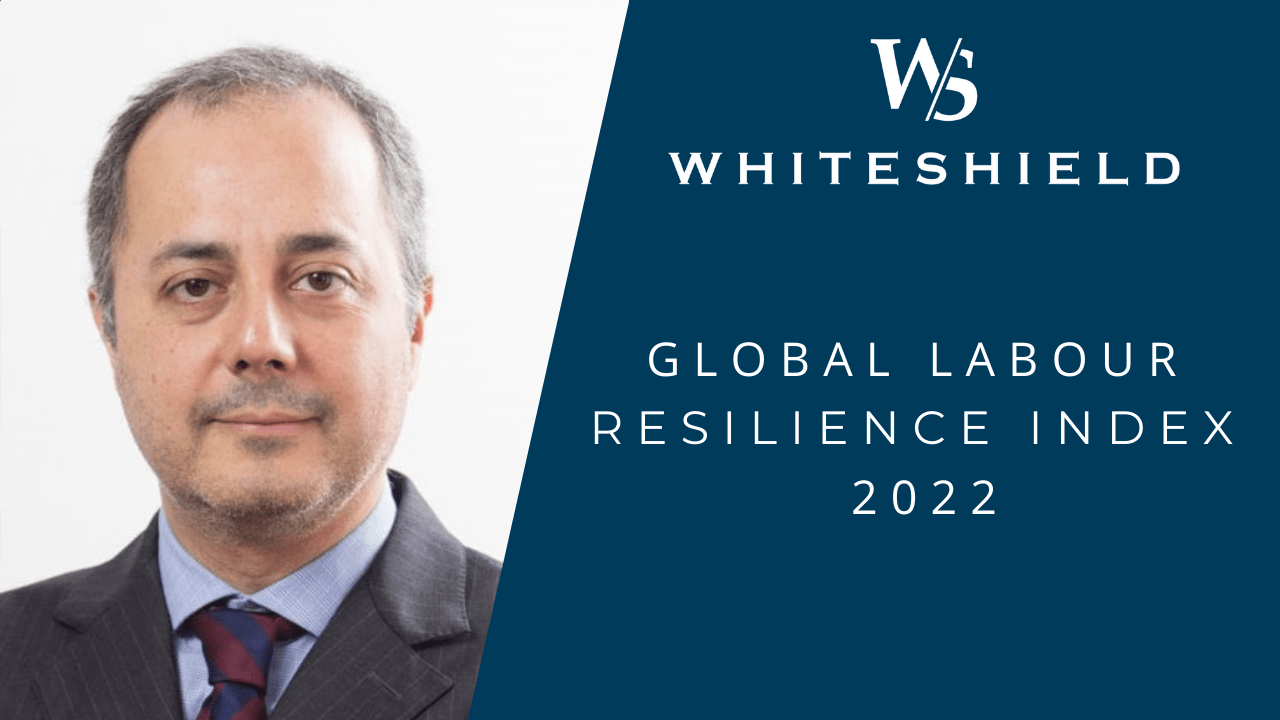Global Labour Resilience Index 2022: Tackling gender inequality in labour markets
March 8th marks International Women’s Day – a day where we are reminded of the stark inequalities present within our societies, labour markets, and financial systems. The 2022 theme for International Women’s Day is #BreakTheBias which signifies the need for us to recognise and defeat the biases experienced by women across the globe.
One area where women still face challenges is in the labour market. Every year Whiteshield produces the Global Labour Resilience Index, which measures the resilience of labour markets to shocks and includes metrics of female labour market participation and equality. Women’s labour market position impacts a labour market’s ability to absorb a shock as it is a metric of inclusivity and precariousness.
The last two years have been challenging for all, but the labour market impact of the COVID-19 crisis has fallen disproportionately onto women. Previous crises have shown that when job losses occur, women are more likely than men to become economically inactive. Subsequently, they can then find it very difficult to re-enter the labour market. Research by the International Labour Organization (ILO) demonstrates that employment losses during COVID-19 translated into increases in economic inactivity, mainly among young women.
The GLRI includes a metric of female participation (measured by the ratio of female to male labour market participation rate) which varies significantly by country. The issue of participation is not one between developing and developed nations. The ratio of female to male participation is highest in many Sub-Saharan African nations, including Rwanda, Angola and Tanzania and remains lowest in many Middle Eastern nations, including Jordan, Saudi Arabia and Egypt.

Saudi Arabia has taken steps to boost the rate of female labour market participation. Vision 2030 outlines its strategy for the country and includes a commitment to boost female labour market participation to 25% by 2030.
However, female participation is only one part of the story. Women in the workplace still face discrimination, unequal pay and challenges when returning to work following motherhood. Another area of importance is the female education pathways. Different education pathways affect career outcomes and earning potential. Research from the UK shows that only 27% of economic undergraduates are female, a percentage that has declined in the last two decades and in the USA, only 34% of STEM graduates are female.

Under the National Innovation and Science Agenda, the government has committed USD 31.2 million in internships and post-school career advice to increase support for females to study and work in STEM.
There is very little international evidence on the gender pay gap – only 43 out of the 136 countries in our Global Labour Resilience Index have available data on the gender pay gap. European or OECD nations are the most likely to provide insights on their gender pay gap. Stark differences are apparent. The average gender pay gap amongst OECD nations is 11.6%, representing how much less women are paid than men. However, the figure stands at 31.5% in Korea whereas, in New Zealand, the gap is only 4.6%.
A big part of addressing the gender pay gap and bias towards women in the workplace is the need to establish equality in mothers’ and fathers’ maternity and paternity rights. All OECD nations, except the US, offer nationwide paid paternity leave. Like in many areas of social policy, the Nordic countries find themselves with some of the best paternity policies.

Sweden has one of the most favourable family support policies. In 2019, the average Swedish woman had 1.7 children (EU average: 1.5) and, at the same time, the rate of working women is the highest in the EU, 78.3%. Fathers are encouraged to take three ‘daddy months’ with 90 days of paid leave reserved for fathers.
Women’s labour market challenges can improve through policy decisions; however, efforts to change policy in favour of equality can be hampered by women’s political representation. Whilst women make up half of the world’s population, they only represent 25% of parliamentary seats. As of September 2021, there are 24 countries where women are serving as heads of state and/or Government. Only four countries have managed to achieve gender equality within their parliament: Rwanda with 61 per cent, Cuba with 53 per cent, Bolivia with 53 per cent, and the United Arab Emirates with 50 per cent.

Belgium has implemented a parliamentary quota at the national and sub-national levels. Candidate lists for political positions must have an equal number of men and women, and lists that do not meet this threshold are rejected. The law goes further to ensure that the top two candidates put forward cannot be of the same gender.
The statistics above show the average position women are in, often painting a falsely positive picture contrary to the reality faced by women from minority backgrounds. However, policymakers have a range of tools at their disposal to improve the labour market outcomes of half of their population. Addressing the labour market bias felt by women must be central to government policy as we look to build resilience ahead of the next crisis. We must #BreakTheBias.
Related insights
Contact us
Subscribe to our newsletter
Subscribe now to receive our latest news




